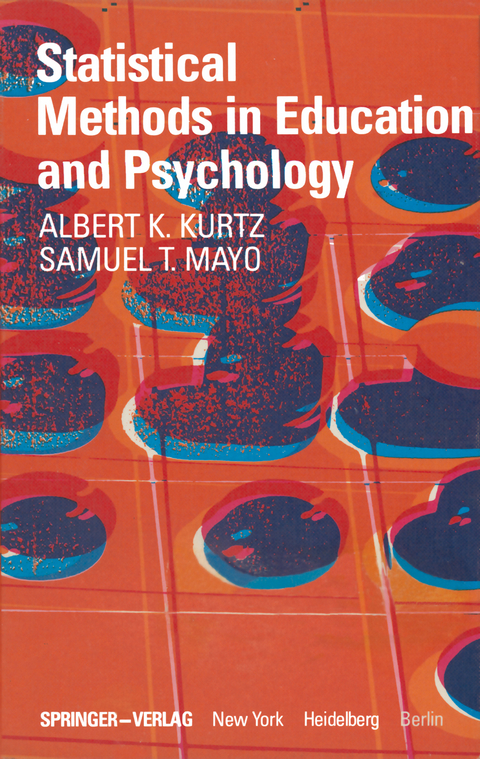
Statistical Methods in Education and Psychology
Springer-Verlag New York Inc.
978-1-4612-6131-5 (ISBN)
1 The Nature of Statistical Methods.- General Interest in Numbers.- The Purposes of Statistical Methods.- Preview of This Text.- Rounding, Significant Figures, and Decimals.- Supplement 1.- Rounding.- 2 Averages.- Raw Data.- The Mean Computed from Raw Data.- Grouping of Data.- The Mean Computed from Grouped Data.- The Median.- Choice of Mean or Median.- The Histogram and the Frequency Polygon.- Summary.- Supplement 2.- Other Averages.- Proof that Error Due to Grouping Is Small.- Cumulative Graphs.- Bar Diagrams.- 3 The Standard Deviation.- Need for a Measure of Variability.- Formula for the Standard Deviation.- Computing the Standard Deviation with Grouped Data.- Standard Deviation of a Finite Population.- Standard Scores.- Other Measures of Dispersion.- Summary.- Supplement 3.- How to Square Numbers.- Methods of Extracting Square Roots.- How to Check Square Roots.- How to Compute and Check the Standard Deviation.- Sheppard’s Correction for Coarseness of Grouping.- Some Other Measures of Dispersion.- Types of Standard Scores.- 4 Normal Probability Curve.- The Nature of the Normal Probability Curve.- The Ordinates of the Normal Probability Curve.- Binomial Coefficients and the Normal Probability Curve.- Applications of the Binomial Coefficients.- The Area under the Normal Probability Curve.- Summary.- Supplement 4.- Simplifying the Equation for the Normal Curve.- Fitting a Normal Probability Curve to Any Frequency Distribution.- 5 Statistical Inference.- Dependability of Figures.- Speculation.- Samples and Populations.- Sampling Distributions and Standard Error of the Mean.- The t Test for Means.- Levels of Significance.- The z Test for Means.- Point and Interval Estimates.- Statistical Inference.- Sampling Distribution and Standard Error of the Median.- SamplingDistribution and Standard Error of the Standard Deviation.- Hypothesis Testing.- Summary.- Supplement 5.- Stability of the Median.- Standard Error of a Proportion.- 6 Percentiles and Percentile Ranks.- Percentiles.- Percentile Ranks.- Computation of Percentiles.- Percentiles and Percentile Ranks Compared.- Deciles.- Quartiles.- Standard Error of a Percentile.- Summary.- Supplement 6.- Method of Obtaining Percentile Ranks for Grouped Data.- Measures of Variability Based upon Percentiles.- The Range.- Relative Value of Measures of Variability.- 7 Skewness and Transformed Scores.- Skewness.- Kurtosis.- Transformed Scores.- The Description of Frequency Distributions.- Summary.- Supplement 7.- Additional Measures of Skewness and Kurtosis.- 8 Pearson Product Moment Coefficient of Correlation.- Definition of Pearson r.- Plotting a Scatter Diagram.- Illustrations of Pearson r’s of Various Sizes.- Published Correlation Coefficients.- Some Characteristics of Pearson r.- Computing r Without Plotting the Data.- Plotting the Data and Computing r from the Scatter Diagram.- The z’ Transformation and Its Standard Error.- Assumptions upon Which Pearson r Is Based.- Interpretation of Pearson r.- Summary.- Supplement 8.- Other Formulas for Pearson r.- Alternate Ways to Test the Significance of an Obtained Pearson r.- Reliability and Validity.- 9 Regression Equations.- The Purpose of a Regression Equation.- Formulas for Regression Equations.- The Use of Regression Equations.- The Graphic Representation of Prediction.- A Second Illustration of Regression Equations.- Further Interpretations of r.- Summary.- Supplement 9.- Making a Large Number of Predictions.- 10 More Measures of Correlation.- Why Other Correlations.- Biserial r.- Multiserial Correlation.- Point Biserial r.-Classification of Dichotomous Variables.- Tetrachoric r.- Phi.- Interrelations among rbis
, rpb
, rt, and ?.- Summary.- Supplement 10.- Cosine Pi Correlation Coefficient.- Rank Correlation Coefficient.- 11 Chi Square.- Nature of Chi Square.- Illustration of Correct Use of Chi Square.- Sources of Error in Chi Square.- Chi Square in the General Contingency Table.- The Exact Test of Significance in 2 × 2 Tables.- Use of Chi Square in Curve Fitting.- Advantages and Disadvantages of Chi Square.- Summary.- Supplement 11.- Unique Characteristics of Chi Square.- 12 Nonparametric Statistics Other than Chi Square.- The Purposes of Nonparametric Statistics.- The Sign Test.- The Runs Test.- The Median Test.- The Mann-Whitney U Test.- Which Nonparametric Statistic Should Be Used?.- Other Nonparametric Statistics.- Summary.- 13 Simple Analysis of Variance.- Why Not the t Test.- The Basis of Analysis of Variance.- A First Example.- Assumptions.- Checking.- Technicalities.- A Second Example.- Summary.- Supplement 13.- 14 Standard Errors of Differences.- Standard Error of Any Difference.- Standard Error of the Difference between Means.- Standard Error of the Difference between Standard Deviations.- The Standard Error of Other Differences.- Summary.- Supplement 14.- 15 Reorientation.- Moments.- Correlation.- Popular Concepts.- Future Courses.- Using Statistics.
| Zusatzinfo | XV, 540 p. |
|---|---|
| Verlagsort | New York, NY |
| Sprache | englisch |
| Maße | 155 x 235 mm |
| Themenwelt | Sachbuch/Ratgeber ► Natur / Technik ► Garten |
| Mathematik / Informatik ► Mathematik ► Statistik | |
| Sozialwissenschaften ► Pädagogik | |
| Sozialwissenschaften ► Soziologie ► Empirische Sozialforschung | |
| Schlagworte | Statistik |
| ISBN-10 | 1-4612-6131-7 / 1461261317 |
| ISBN-13 | 978-1-4612-6131-5 / 9781461261315 |
| Zustand | Neuware |
| Informationen gemäß Produktsicherheitsverordnung (GPSR) | |
| Haben Sie eine Frage zum Produkt? |
aus dem Bereich


